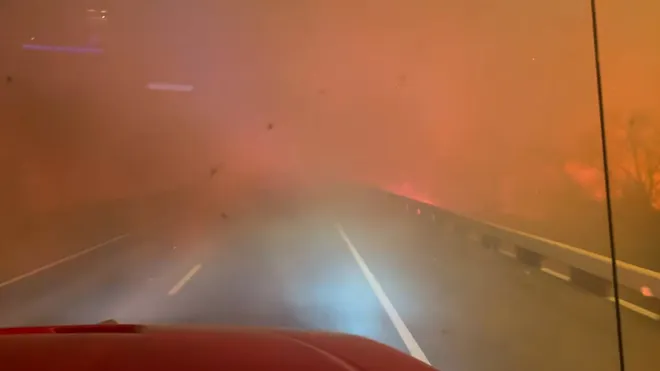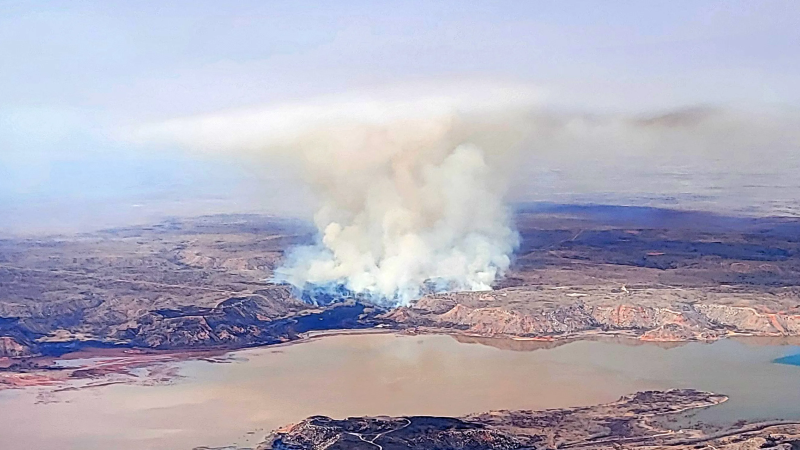Texas Smokehouse Creek Fire grows to largest in state's history: Live updates
Wildfires continued to roar across the Texas panhandle Thursday, forcing widespread evacuations and causing one death as the Smokehouse Creek Fire became the largest in the state's history.
As of Thursday morning, 130 fires were burning across the state, according to the Texas A&M Fire Service. The largest of the blazes, the Smokehouse Creek Fire, had consumed 1 million acres, an area larger than the state of Rhode Island, and was just 3% contained by Thursday.
The Smokehouse blaze caused a brief shutdown of a nuclear plant earlier in the week. The 687 Reamer Fire fed into it after consuming an additional 2,000 acres of land.
“This is now the largest fire in recorded Texas history,” Erin O’Connor, lead public information officer for Texas A&M Forest Service, said Thursday. The fire's acreage indicates land within the burn zone, she said.
On Tuesday, Texas Gov. Greg Abbott issued a disaster declaration for 60 counties in Texas, and on Wednesday, he directed the Texas Division of Emergency Management to increase its readiness level in response to the fires.
Other blazes also continued to rage Thursday across the state. The Windy Deuce fire had burned at least 142,000 acres and was 30% contained. The Grape Vine Creek Fire was almost two-thirds contained after it tore through 30,000 acres, and the Magenta Fire had burned through an additional 2,500 acres.
O'Connor said there had only been one official death from the Smokehouse blaze – Joyce Blankenship, 83, from the small town of Stinnett. The number of structures that have been damaged or destroyed isn’t yet known though teams are investigating, she said.
Reduced winds and future rain could help slow the fires
On Thursday, fire activity was minimal, in part because the winds had died down, O'Connor said, although they may pick up this weekend. Some precipitation is forecast this week, which could slow the fire, she said. "Our firefighters should be able to make good progress and increase containment over the next couple of days."
According to a report last year by the Texas State Climatologist, wildfire risk in the state is projected to increase because of increased rates of drying and increased fuel load: Intense rains create the conditions for larger than usual scrub grass and brush growth, then droughts dry the area out, which makes the land more liable to burn.
In the Texas Panhandle, where the Smokehouse Creek Fire and others are burning, the land is flat, grassy and brush-filled, giving any fires that do start ample fuel to burn.

Nearby counties evacuate after heat fuels fires
Local officials ordered the evacuation of Hemphill County on Tuesday afternoon in response to the fire. Less than an hour later, the sheriff's office announced that a major highway evacuation route was closed and advised that residents shelter in place in the town of Canadian.
The Texas A&M Service said a "moderate to high fire potential for wildfires" detected on Tuesday would relax later in the week but would increase on the state's plains amid strong winds forecast over the weekend.
Strong winds in a dry environment, fueled by record-high temperatures for the time of year, allowed the fire to rapidly spread after it sparked on Monday. Temperatures early in the week in the northern part of the state reached as high as the mid-80s, abnormal for this time of year. Then came extremely high winds.
The National Weather Service forecast on Monday noted gusts up to 60 mph. “As if that wasn't enough, we've also had record warm temperatures this morning and afternoon, with the opportunity to break another warm temperature record overnight," the weather service said.
Also on Tuesday, the fires closed the Pantex nuclear plant northeast of Amarillo, causing officials at the plant to halt operations that evening. The plant resumed normal operations on Wednesday.
How unusual is a Texas wildfire in February?
Large fires in the Texas Panhandle are not unusual, O’Connor said. “It’s not unheard of to have these large fires in this part of the state,” she said.
Fire activity typically begins in October and November and runs through mid-April, depending on conditions.
The winter fire season, sometimes called the dormant fire season, runs from February through April and sees the most fires spread out of the year. Those fires can blossom as cold fronts bring high winds into the state putting winter-dry grasses and vegetation at risk.
The summer wildfire season runs August through October, when high heat and dry conditions can spark conflagrations. These fires are especially bad in years with wet falls and winters followed by summer droughts, which create large amounts of fuel.
That was the case of the Bastrop Fire in 2011, the most destructive in the Lone Star state’s history. It killed two people, burned more than 32,000 acres and destroyed more than 1,500 homes.

Before the Smokehouse Creek Fire took the title, the largest fire in Texas state history was the East Amarillo Complex fire. The fire ignited in Hutchinson County on March 12, 2006, and blazed through more than 907,000 acres, according to the Texas A&M Forest Service.
It also caused 13 fatalities, making it the deadliest in the state's history.
Historically, slightly more than 1% of the state’s land has burned each decade since 1984. Climate models project an increase as soil and vegetation become drier by 2100.
Small town hit by fire remembers destruction of 2014 wildfire
The small town of Fritch hunkered down as wildfires approached this week, nearly a decade after another wildfire unleashed destruction on the small community.
As the Windy Deuce fire crept closer, officials ordered evacuations in the southern part of the town. The Moore County Sheriff's Office said it was assisting residents to evacuate.
Fritch Mayor Tom Ray said around 50 homes had already been destroyed in the blaze.
"Today your Fritch Volunteer Fire Department mourns for our community and those around it," fire officials posted on Facebook. "We are tired, we are devastated but we will not falter. We will not quit."
The fire wrought destruction on the city's infrastructure, causing hundreds to lose power this week.
The power outages also brought down the city's water system. Officials announced a boil water notice on Wednesday morning until further notice. The city set up a local church as a bottled water distribution center in response.
The tragedy recalled May of 2014, when another wildfire that scorched the North Texas area devastated Fritch. The flames forced more than 2,000 people to evacuate and damaged or destroyed hundreds of homes. One person in the town died of a heart attack amid the disaster.
The fire ignited in the midst of a years long drought throughout the state that began in 2010 and took a heavy toll on Texas' agriculture-dependent economy. It also devastated small communities throughout the Panhandle and scorched thousands of acres.
"We have seen tragedy today and we have seen miracles," local deputies posted on Facebook on Tuesday. "Today was a historic event we hope never happens again. The panhandle needs prayers."
Contributing: Dinah Pulver
Disclaimer: The copyright of this article belongs to the original author. Reposting this article is solely for the purpose of information dissemination and does not constitute any investment advice. If there is any infringement, please contact us immediately. We will make corrections or deletions as necessary. Thank you.


